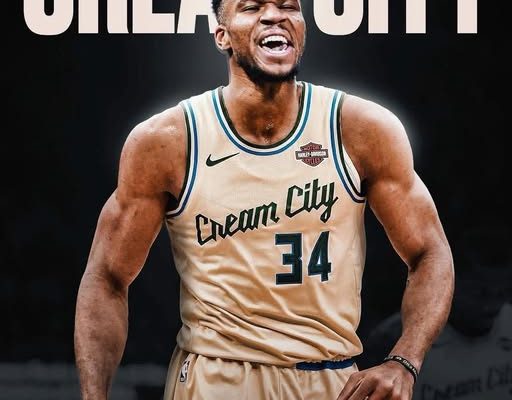The return of the Cream City jerseys marks not only a revival of one of the NBA’s most beloved alternate uniforms but also a renewed sense of identity and pride for the city of Milwaukee. At the center of this resurgence is Dustin Godsey, the Chief Marketing Officer of the Milwaukee Bucks, whose vision and tenacity have helped reintroduce the Cream City aesthetic to a new generation of fans while honoring the city’s deep cultural roots and basketball heritage. This isn’t just about fabric and font; it’s about legacy, connection, and a brand that resonates far beyond the court.
When the Cream City jerseys first debuted in the 2019-2020 NBA season, they were an immediate hit. Drawing inspiration from the city’s iconic Cream City brick, the colorway wasn’t just unique — it was intimate, distinctly Milwaukee, and a proud departure from the traditional color palettes used across the league. Fans embraced it because it was theirs. The Cream City brick, made from locally sourced clay and limestone, is a cornerstone of Milwaukee architecture. From city halls to breweries, the brick tells a story of craftsmanship, resilience, and local pride. Translating that spirit into a jersey was a bold move, but one that paid off in authenticity and popularity.
Dustin Godsey knew what the city needed even before the demand was obvious. His team’s branding initiatives have always focused on tapping into the city’s soul — from the gritty industrial past to the burgeoning cultural renaissance of modern-day Milwaukee. He didn’t want the Bucks to just be a basketball team; he wanted them to be a symbol of the city’s identity. And the Cream City jerseys quickly became that symbol.
But trends fade, and by the 2021-22 season, the Cream City uniforms had been shelved in favor of other designs. Fans were disappointed, voicing their opinions on social media, during games, and even at official Bucks events. The jersey had become more than an alternate uniform — it was a statement, a badge of honor. Godsey and his team took note. They knew the absence wasn’t just felt on the racks at the team store, but in the hearts of a city that had embraced the Cream City brand as its own.
Bringing the Cream City jerseys back wasn’t just a matter of responding to public demand; it was a strategic decision rooted in storytelling, heritage, and timing. With the Bucks coming off a period of franchise transformation — from their 2021 championship to the new roster dynamics and a rejuvenated focus on community — the return of Cream City attire aligned perfectly with a broader narrative of renewal. And Dustin Godsey made sure the return wasn’t just nostalgic; it was purposeful.
From a marketing standpoint, Godsey’s strategy was multi-faceted. The return of the jerseys came with a series of campaigns that included social media rollouts, collaborations with local artists and influencers, and limited-edition merchandise drops. But perhaps the most impactful aspect was how the return was positioned — not merely as a comeback, but as a homecoming. This was Milwaukee reclaiming its voice in the NBA style scene.
Godsey worked closely with Nike, the NBA’s official apparel partner, to ensure the materials, cut, and aesthetics of the new Cream City jerseys honored the original while introducing modern refinements. Every stitch was scrutinized, every hue tested against historical references and city landmarks. The updated version featured a slightly more contemporary font and a refined trim, giving it a polished feel without compromising its roots. Godsey knew that to win the fans back, it had to be right — not just close.
And fans responded in kind. The moment the Bucks teased the return with a cryptic Cream City social media post, speculation exploded. Within hours, #CreamCity was trending in Wisconsin and parts of the Midwest. Fans posted old photos wearing the original jerseys, recounted memories from Giannis Antetokounmpo’s MVP season, and even shared artwork inspired by the uniform. This wasn’t just excitement; it was a full-on cultural moment.
For Godsey, this was validation. Years of cultivating a brand identity rooted in local pride had finally created something bigger than basketball. It wasn’t just about the Bucks winning games or Giannis dominating in the paint — it was about what the team represented. Milwaukee, once overshadowed by larger NBA markets, now stood confidently with its own aesthetic, its own style, and its own story.
The return of the Cream City jerseys also tapped into a broader NBA trend: localized branding. More and more, teams have been looking to reflect their cities in ways that feel organic and intimate. Portland’s “City of Roses” design, Miami’s “Vice” color scheme, and Denver’s “Rainbow Skyline” reboots all exemplify this movement. But what sets Milwaukee’s Cream City apart is its specificity and subtlety. There’s no flash here — just a quiet elegance that speaks volumes.
Godsey’s role in making this possible can’t be overstated. He understood the emotional resonance fans had with the Cream City look, but he also recognized the opportunity for broader storytelling. Working alongside creative teams, Godsey helped launch a series of video vignettes and short documentaries that profiled local figures — brickmakers, artists, historians — all of whom contributed to the fabric of Milwaukee in different ways. These stories were used to draw a straight line between the Cream City aesthetic and the real-life people who made the city what it is. In effect, the campaign turned the jersey into a canvas of civic pride.
One of the most poignant stories came from a segment about a local mason whose family had been working with Cream City brick for generations. The mason spoke with teary-eyed reverence about seeing his work mirrored in the Bucks’ uniform and what it meant to have that legacy honored on such a visible platform. It was a reminder that what may seem like simple branding to some can be a source of deep connection to others.
From a financial standpoint, the move paid off handsomely. Merchandise sales soared within days of the re-release. The Bucks’ team store saw its busiest week of the offseason, and online orders came in from all 50 states and a dozen countries. More than a fashion statement, Cream City was now a global export. Godsey and the Bucks’ front office had found a way to take something hyper-local and make it universal. And that is no easy feat in today’s crowded sports and entertainment landscape.
The jerseys were worn for the first time since their return during a highly anticipated home game, complete with a “Cream City Night” event that turned Fiserv Forum into a brick-themed celebration of all things Milwaukee. Local musicians performed, Cream City-inspired snacks were served, and the halftime show featured a tribute to past Bucks players who had donned the uniform during its original run. The arena wasn’t just watching a game — it was experiencing a love letter to the city itself.
Even players, many of whom weren’t on the roster during the original Cream City era, embraced the jerseys. Giannis Antetokounmpo, long considered the face of the franchise, voiced his support for the design, calling it “a perfect tribute to the city that raised me.” Younger players like MarJon Beauchamp and Andre Jackson Jr. echoed that sentiment, with some even taking to social media to express their excitement about repping the Cream City name.
That level of buy-in from both fans and players is rare, and it speaks to how thoughtfully Godsey approached the process. He didn’t just green-light the return; he built a world around it. The Cream City jerseys weren’t simply revived — they were elevated, matured, and recast in a narrative of pride, resilience, and homecoming.
It’s easy to overlook the impact of branding in professional sports, especially when wins and losses dominate headlines. But moments like these — where a uniform becomes a rallying point for an entire community — remind us that the soul of a franchise is as much about the people in the stands as it is about the scoreboard. Dustin Godsey understood that, and he acted accordingly.
Now, as Milwaukee looks to the future — both in basketball and beyond — the Cream City jerseys serve as a reminder of where it all began. They’re not just garments. They’re artifacts. Proof that a team and a city can move as one when the story is told right. And for the Bucks, that story is far from over. With the return of the Cream City jerseys, Dustin Godsey didn’t just bring back a fan favorite. He brought Milwaukee home to itself.



